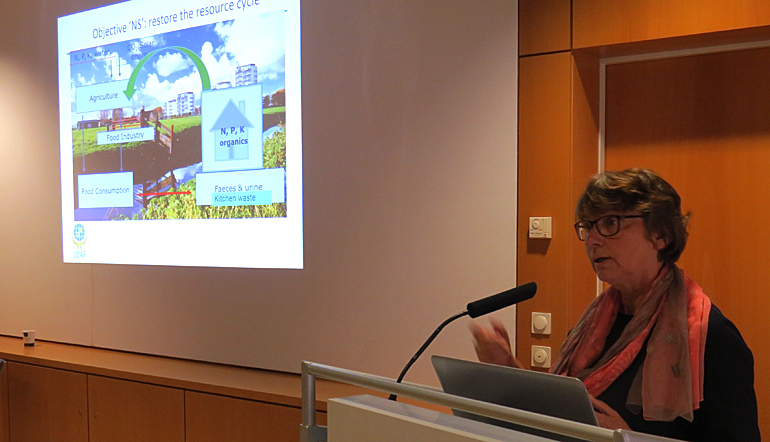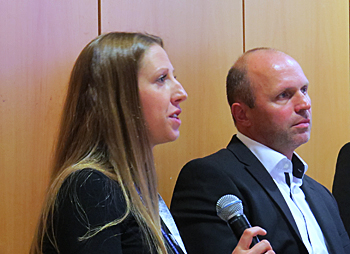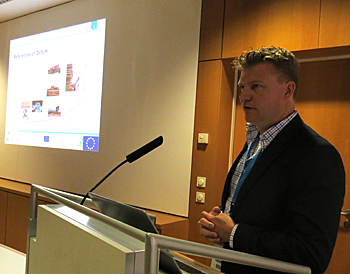IFAT 2018: Potential of renewable nutrients from sewage sludge left untouched

In Germany there is not enough capacity to recover nutrients from sewage sludge. Although many municipal waste water treatment plants are required to recover phosphate from their sludge, the real recovery is left untouched.
‘There is currently too little capacity to do so and the sludge is now stored’, revealed Christan Kabbe of Ilse Utilities at the opening of a special workshop of the EU Run4Life research project at the IFAT trade fair in Munich on 17 May.
Kabbe showed pessimism about a rapid improvement. ‘The German law on nutrient recovery can be changed overnight. This uncertainty makes the waste treatment sector reluctant to invest in additional recovery capacity’, Kabbe said at IFAT.
The situation in Germany is not an isolated case. In Switzerland the mandatory phosphate recovery leads to the storage of struvite. In the Netherlands the recovery is not yet mandatory and recovery projects do not scale up.
 Ostara's Andrea Gysin explained the success of her company as it sees itself as a fertilizer company, not as a supplier of sludge treatment technology.
Ostara's Andrea Gysin explained the success of her company as it sees itself as a fertilizer company, not as a supplier of sludge treatment technology.
Involving fertilizer sector
The big problem is that the fertilizer market is reluctant to take up renewable nutrients. The only success reported at the Run4Life meeting was by the Canadian company Ostara.
According to Andrea Gysin, Ostara can operate successfully because it sees itself as a fertilizer company. ‘We now have 14 factories operational worldwide where we produce our carefully developed Crystal Green struvite from sewage sludge. Our big challenge is now to upscale the volume’.
Gysin told that her company has found a niche market in selling its Crystal Green to potatoes farmers. ‘We can develop more such niche crops but we can also increase the blending of our product in compost.’
Decentralized treatment
Gysin identified the problem of the small struvite volumes produced at each waste water treatment plant. Ostara sees it as a challenge to bring together these volumes.
At the same time, the Run4Life project looks at possibilities to treat sewage water more locally, at district level. On this topic two Dutch participants of the Run4Life project contributed with a presentation.
Brendo Meulman of Desah explained that his company has been active for ten years in the construction of decentralised treatment plants, based on the separated collection of grey waste water (from showers, washing machines and washbasins) and black water (from toilets and kitchen).
 Director Brendo Meulman at Desah told that after ten years of small decentralised treatment plants, the market is finally picking up to the +1000 inhabitants scale the Desah-technology needs commercially
Director Brendo Meulman at Desah told that after ten years of small decentralised treatment plants, the market is finally picking up to the +1000 inhabitants scale the Desah-technology needs commercially
Specialized sales companies
In his presentation Meulman identified the most important issue in his view: ‘We can think of the most fancy projects, but we cannot scale up if nobody wants to sell or to buy our recovered products’.
Desah participates in the Run4Life project to develop a closer relation to companies that sell the recovered products. Meulman: ‘We are involved in the grey water reuse and black water treatment at four selected demo locations. There we want to achieve 90 percent fresh water re-use and 90 percent nutrient recovery.’
The locations are in Helsingborg (Demark), Gent (Belgium), Vigo (Spain) and Sneek (the Netherlands).
Ground-breaking nutrient recovery strategies
Senior consultant Grietje Zeeman (on top photo) of the Dutch-based foundation Leaf gave a presentation on the development of new technologies to treat separated grey and black water streams.
Zeeman introduced the new Run4Life demonstration project to start in Sneek, the Netherlands. ‘At the current decentralized plant in Sneek, we cannot link the effluent of the anaerobic sludge reactor directly to our struvite reactor. First we need to remove the nitrogen’.
She pointed out that the current vacuum toilets still produce too high volumes of black water. ‘By using the newest ultra-low flushing toilets we can reduce the water use from 3 to 2 liters per flush. This enabled us to develop a new concept at the Wageningen University to produce calcium-phosphate granules inside the UASB anaerobic reactor. With less black water volumes, we can increase the temperature in the one-step reactor and use hyperthermophilic fermentation technology.
Zeeman told that the Run4Life project will also test a new technology of the Spanish demonstration side in Vigo. ‘At the office complex there, we will use a bioelectrical technology that is currently under development. We hope to be able to recover nitrogen from the reactor effluent, producing potassium fertilizer’.
Read also on this website
● IFAT 2018: Colsen presents water supply plant for company in dry running Cape Town, South Africa, 24 May 2018
● IFAT 2018: How Nijhuis links tasteful mint to waste water, 18 May 2018
● IFAT 2018: Call on EU to develop standards for micropollutants in waste water, 15 May 2018
● IFAT 2016: Three giant H2O molecules hanging over Dutch pavilion symbolize circular water use, 31 May 2016
● IFAT2014: Vibrant water tech business at Holland pavilion in pictures, 11 May 2014
● Meet the Dutch water in the Netherlands water pavilion at IFAT2018 (Hall B2 - booth 104/205)
More information
IFAT 2018
www.ifat.de
Desah
Sneek, the Netherlands
+31 515 486 846
www.desah.nl
Leaf
Wageningen, the Netherlands
+31 317 484 208
www.leaf-wageningen.nl



